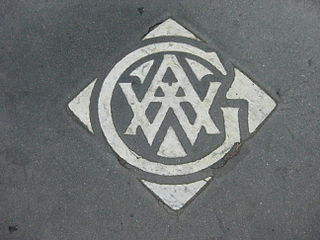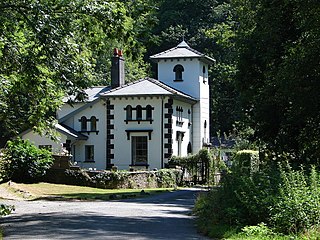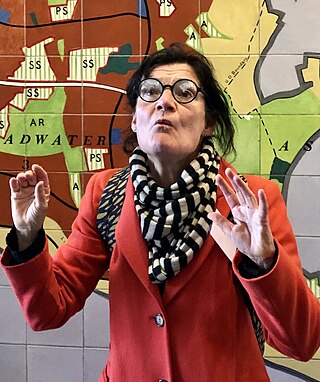The year 1907 in architecture involved some significant architectural events and new buildings.

The Royal Institute of British Architects (RIBA) is a professional body for architects primarily in the United Kingdom, but also internationally, founded for the advancement of architecture under its royal charter granted in 1837, three supplemental charters and a new charter granted in 1971.

Sir John Morris-Jones was a Welsh grammarian, academic and Welsh-language poet.
The Centre for Alternative Technology (CAT) is an eco-centre in Montgomeryshire, Powys, Wales dedicated to demonstrating and teaching sustainable development. CAT, despite its name, no longer concentrates its efforts exclusively on alternative technology, but provides information on all aspects of sustainable living. It is open to visitors, offers postgraduate degrees as well as shorter residential and one day courses; and publishes information on renewable energy, sustainable architecture, organic farming, gardening, and sustainable living. CAT also runs education programmes for schools and sells environmentally friendly items through its on site shop, restaurant and mail order department.

The Art Workers' Guild is an organisation established in 1884 by a group of British painters, sculptors, architects, and designers associated with the ideas of William Morris and the Arts and Crafts movement. The guild promoted the 'unity of all the arts', denying the distinction between fine and applied art. It opposed the professionalisation of architecture – which was promoted by the Royal Institute of British Architects at this time – in the belief that this would inhibit design. In his 1998 book, Introduction to Victorian Style, University of Brighton's David Crowley stated the guild was "the conscientious core of the Arts and Crafts Movement".
This article is about the particular significance of the year 1903 to Wales and its people.

The Cambrian Archaeological Association was founded in 1846 to examine, preserve and illustrate the ancient monuments and remains of the history, language, manners, customs, arts and industries of Wales and the Welsh Marches and to educate the public in such matters. The association's activities include sponsoring lectures, field visits, and study tours; as well as publishing its journal, Archaeologia Cambrensis, and monographs. It also provides grants to support research and publications.

Edith Mary Wardlaw Burnet Hughes HonFRIAS was a Scottish architect, and is considered Britain's first practising female architect, having established her own architecture firm in 1920.
Ruth Reed is a British architect and was the first woman to be elected president of the Royal Institute of British Architects (RIBA) 2009–2011. She was brought up in Shrewsbury and now lives in Birmingham.
The Royal Society of Architects in Wales (RSAW) is the Wales region of the Royal Institute of British Architects (RIBA). The society was granted Royal status by the Privy Council in 1994.
The Department of Architecture is part of the Faculty of Architecture and History of Art in the University of Cambridge. Both Departments are housed in Scroope Terrace on Trumpington Street, Cambridge.
Stiff + Trevillion is a London-based architectural practice founded in 1981 by Michael Stiff and Andrew Trevillion. By 2014, the firm had 40 staff members and had worked on over 2,000 projects. Designing both buildings and interiors their work covers the commercial, residential, restaurant and retail sectors, primarily in London but also across the UK and overseas. Some of their projects include the first Wagamama restaurant in 1992 and the first in the chain of Giraffe Restaurants. They have also designed various Italian restaurants for Jamie Oliver. Their residential clients have included Adele and Blur (band) and Gorillaz frontman Damon Albarn.
Donald Insall Associates is a firm of architects, designers and historic building consultants in the United Kingdom.

Harold Hughes or Henry Harold Hughes (1864–1940) was born in Liverpool and trained as an architect under Arthur Baker in London. He qualified as an ARIBA in 1890 and set up an architectural practice in Bangor in 1892, where he remained until his death in 1940.

Richard Kyrke Penson or R. K. Penson was a Welsh architect and artist.
Philip Dalton Hepworth was a British architect. He studied in both the UK and France, at the Architectural Association School of Architecture and the École des Beaux-Arts, and returned to work as an architect after serving in the First World War. He rose to prominence in the 1930s, featuring in a book by architectural critic Trystan Edwards and winning the commission in 1932 to design Walthamstow Town Hall, which was eventually completed in 1942. Another civic building of this period was Wiltshire County Hall at Trowbridge. He also designed a handful of private houses, including Pemberley, in Loughton, 1936. He lived in Zoffany House in Strand-on-the-Green, Chiswick, London, from 1936.

Elain Harwood Hon.FRIBA was a British architectural historian with Historic England and a specialist in post–Second World War English architecture.
Sidney Colwyn Foulkes OBE FRIBA FILA AMTPI (1884-1971) was a Welsh architect, especially known for his architectural designs in Colwyn Bay, cinemas and council estates in North Wales. He was one of the first industrial landscape architects in Britain.










